Marvel Studios has become the master of extracting as much value from a concept as any corporation in the world - except one.
Each year we’re bombarded with at least a couple of superhero movies and even more television shows, so much so now that the term ‘superhero fatigue’ has entered our social consciousness. We no longer care if Thor or Spider-Man save the day because we’ve seen so many world-ending disasters being stopped at the last minute we can no longer feel excited.
Porsche, though, is able to create one spin-off after the other and still have true motoring enthusiasts getting sweaty palms and elevated heart rates. The current 992-generation 911 range included a frankly mind-boggling 23 variants, from standard Carrera all the way up to the race-car-in-disguise GT3 RS and the full-speed, full-lux Turbo S.
And yet, somehow the German maker found room for a 24th variant. How? By going off the beaten track. Literally.
The Porsche 911 Dakar is unlike anything the brand has done before, taking the iconic sports car and giving it an off-road twist.
So, what is it exactly? Well, for those unfamiliar, the Dakar Rally is an off-road race that typically lasts two weeks and sees competitors take on the roughest and toughest conditions the desert can throw at them. It’s a gruelling and sometimes fatal challenge, but it’s the toughest test of human and machine.
It’s also typically contested by large, SUV-based vehicles. In recent years it was Toyota HiLuxes and Volkswagen Touaregs doing the winning, while in the early days it was Range Rover.
Porsche won the Dakar Rally in 1984, using a specially modified version of its 911 to beat its conventional off-roader competition.
To celebrate that victory, and add one more variant to the 911 range, Porsche created this jacked-up, beefed-up version of its sports car.
But is it all looks and no substance? We went bush to find out…
Porsche 911 2024: Dakar
| Engine Type | Flat 6, 3.0L |
|---|---|
| Fuel Type | Premium Unleaded Petrol |
| Fuel Efficiency | 10.5L/100km (combined) |
| Seating | 2 |
| Price From | $450,890 - $518,210 |
Price and features – Does it represent good value for the price? What features does it come with?
10 / 10
At first glance you might just think the 911 Dakar is just a sticker pack and a new set of wheels and tyres, but you’d be very wrong.
Yes, there is a sticker pack (more on that later) but Porsche has made some pretty significant engineering changes for the Dakar. Enough that the company claims it now has similar ground clearance and approach angles of a “conventional SUV.”
These changes include up to 50mm more ground clearance than a standard 911 Carrera, plus an extra 30mm of lift when needed from the hydraulic suspension. This higher height isn’t speed restricted, so you can stay lifted and put your foot down, which is perfect for high-speed off-road driving.
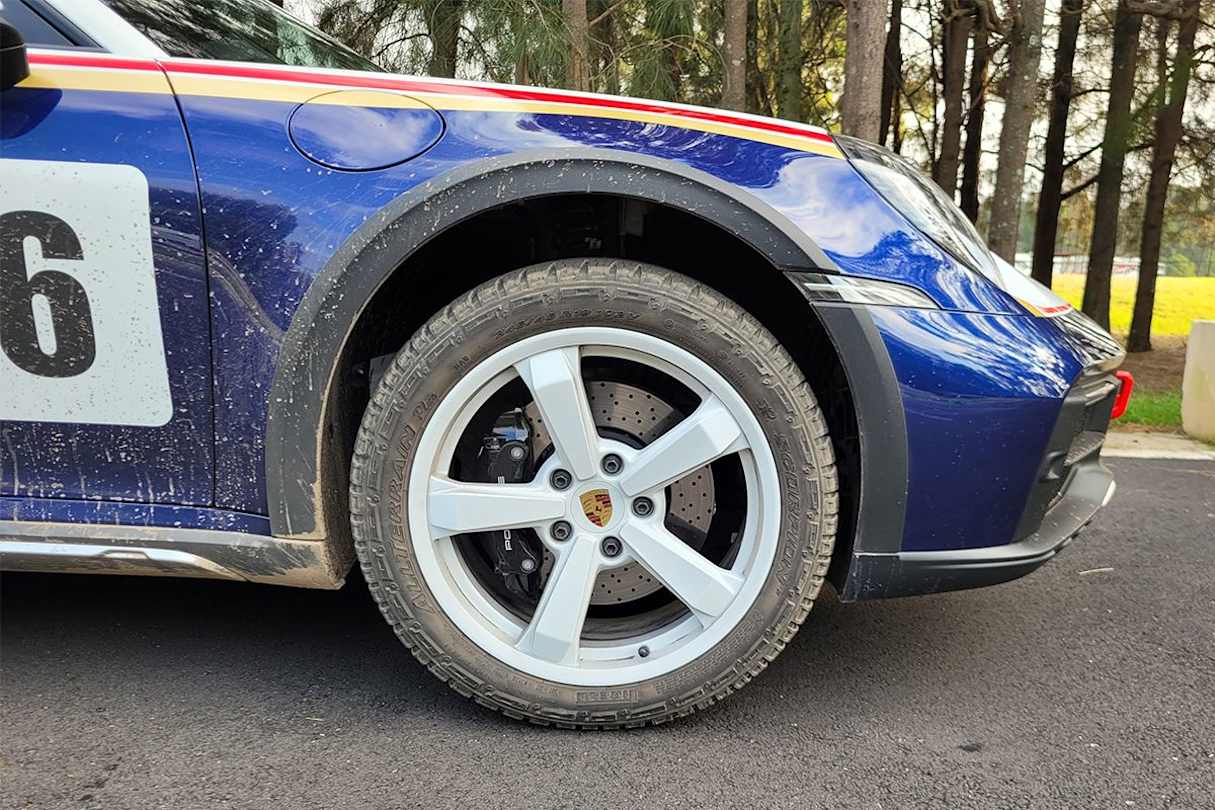
There are unique five spoke, forged alloy wheels (19-inch front, 20-inch rear) fitted with specifically designed Pirelli Scorpion All Terrain Plus tyres. To fit this new package there are wider wheel arches with stainless steel for extra protection.
Other unique additions include red aluminium towing points front and rear, a new front bumper with underbody protection and a new, fixed rear spoiler. The bonnet is also very similar to the one found on the 911 GT3, made from carbon-fibre reinforced plastic to save weight.
Porsche has added rear-wheel steering as standard on the Dakar, as is its 'Dynamic Chassis Control' anti-roll stabilisation system, with both intended to help its off-road prowess.
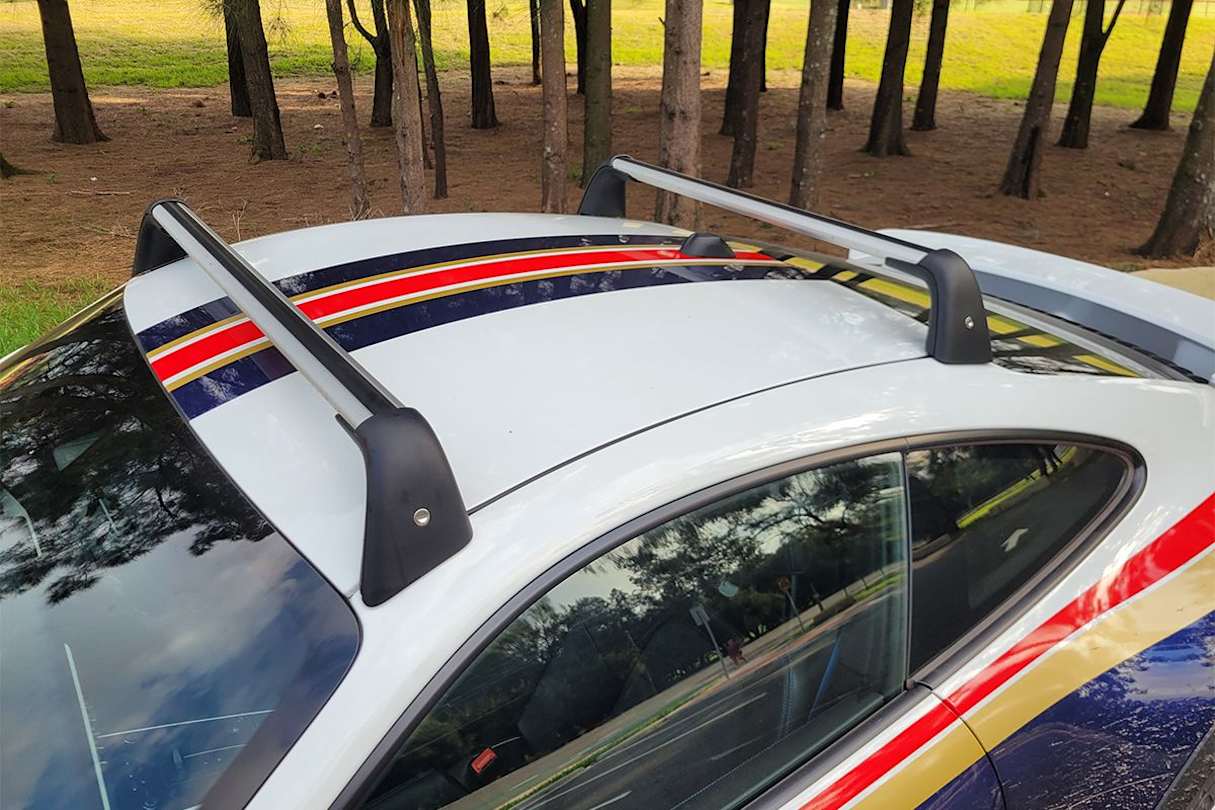
There are some notable - and unusual - optional extras for this version of the 911. These include roof racks able to incorporate a lightbar and/or an extra storage rack that can take on an additional 42kg of luggage. Shovels, traction boards, spare tyres and fuel or whatever else you need for an outback adventure. You can even add an optional tent if you want to go camping in your Porsche 911.
Despite an official asking price of $491,400 (plus on-road costs) it’s hard not to give this 911 a perfect score for price because this is one of the very few cars that will almost certainly appreciate in value, rather than shed it. Porsche is building just 2500 examples of the 911 Dakar globally, so these will become a collector’s item and should be priced accordingly.
Design - Is there anything interesting about its design?
9 / 10
As you can see in these images, our test car was fitted with the optional 'Rallye Design Package'. It adds another $54,730 to the cost but brings with it this head-turning paint scheme inspired by the racing livery from the 1984 winner. It’s actually a two-tone paint job with a wrap, the first time Porsche has produced such a finish on any of its production cars.
The ‘Roughroads’ is a substitute for the original cigarette brand that sponsored the car, while the white and blue scheme, with red and gold highlights is almost identical to the ‘84 car. Owners could pick any racing number between one and 999, our test car had #176 because that’s the number carried by the winning car.
The Rallye Design Package isn’t just a fresh look, too, it also adds the white wheels, a half roll cage, six-point racing-style harnesses and a fire extinguisher, so you can enter motorsport competitions and really push your Dakar to its limits.
Practicality – How practical is its space and tech inside?
7 / 10
The interior is probably the most ‘normal’ 911 element of the Dakar. Yes, it’s strictly a two-seater (even without the optional roll cage), but it doesn’t feel much different to a GT3, especially as the brand’s 'Race-Tex' synthetic suede is the standard trim material. The only exception is the unique ‘911 Dakar’ badge on the passenger side of the dashboard, which tells you exactly which one of the 2500 examples yours is.
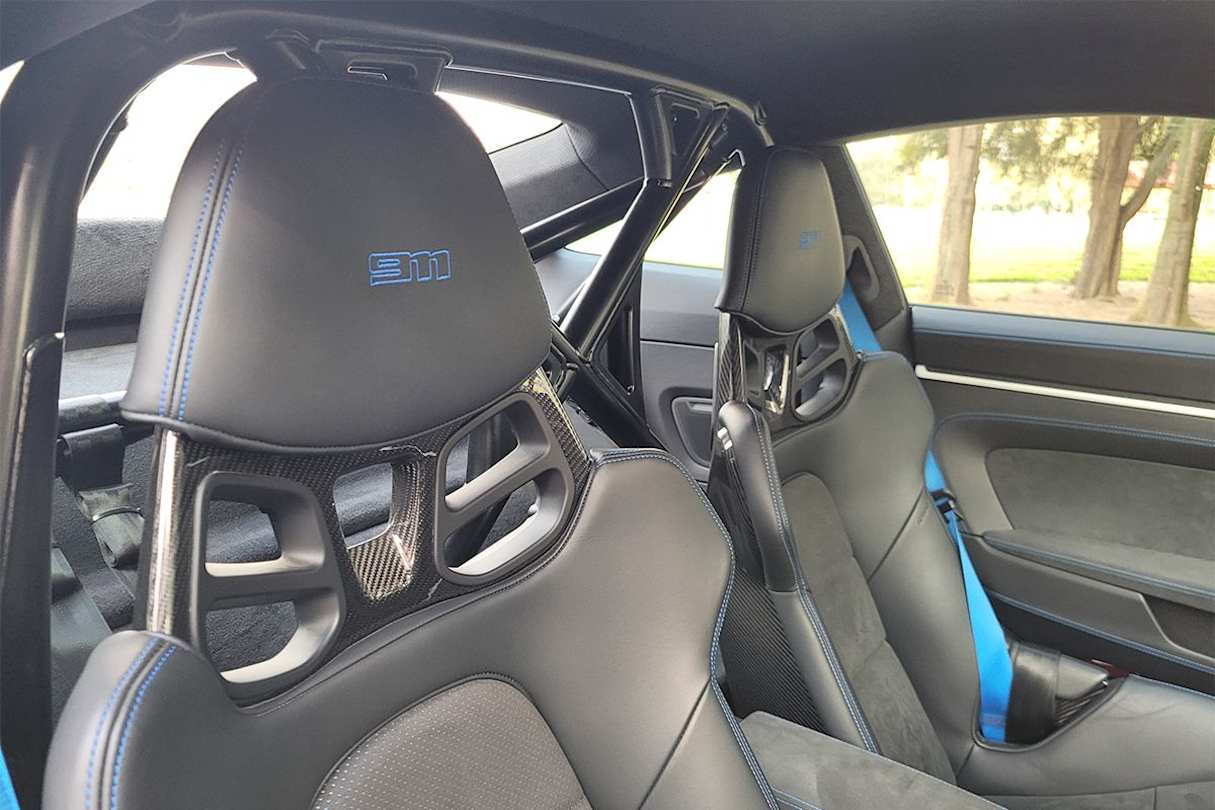
While Race-Tex is the primary trim, there’s plenty of leather elements and contrasting stitching to give a premium look and feel. The standard seats in the Dakar are the lightweight full bucket sports seats, made from carbon-fibre reinforced plastic and also trimmed in Race-Tex. This adds to that sporty, GT3-like feeling. They’re comfortable when you’re in them, but as they’re quite deep they make getting in and out a bit trickier than the standard Porsche chairs.
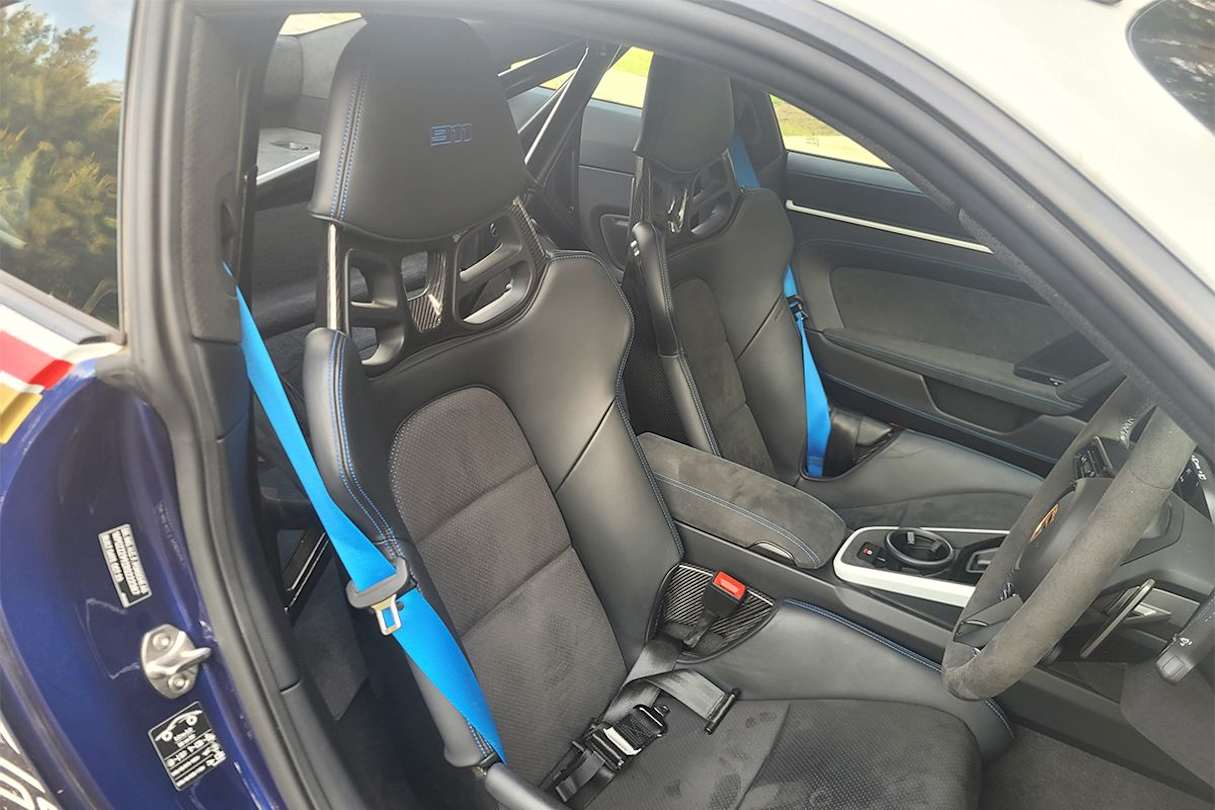
The rest of the technology is standard Porsche. The multimedia system is as simple and intuitive as ever, one of the better examples on the market today, which is something you typically think of with Porsche but it shows the company’s attention to all the details.
The Dakar comes equipped with a Bose surround sound system and full smartphone integration, with wireless Apple CarPlay and Android Auto.
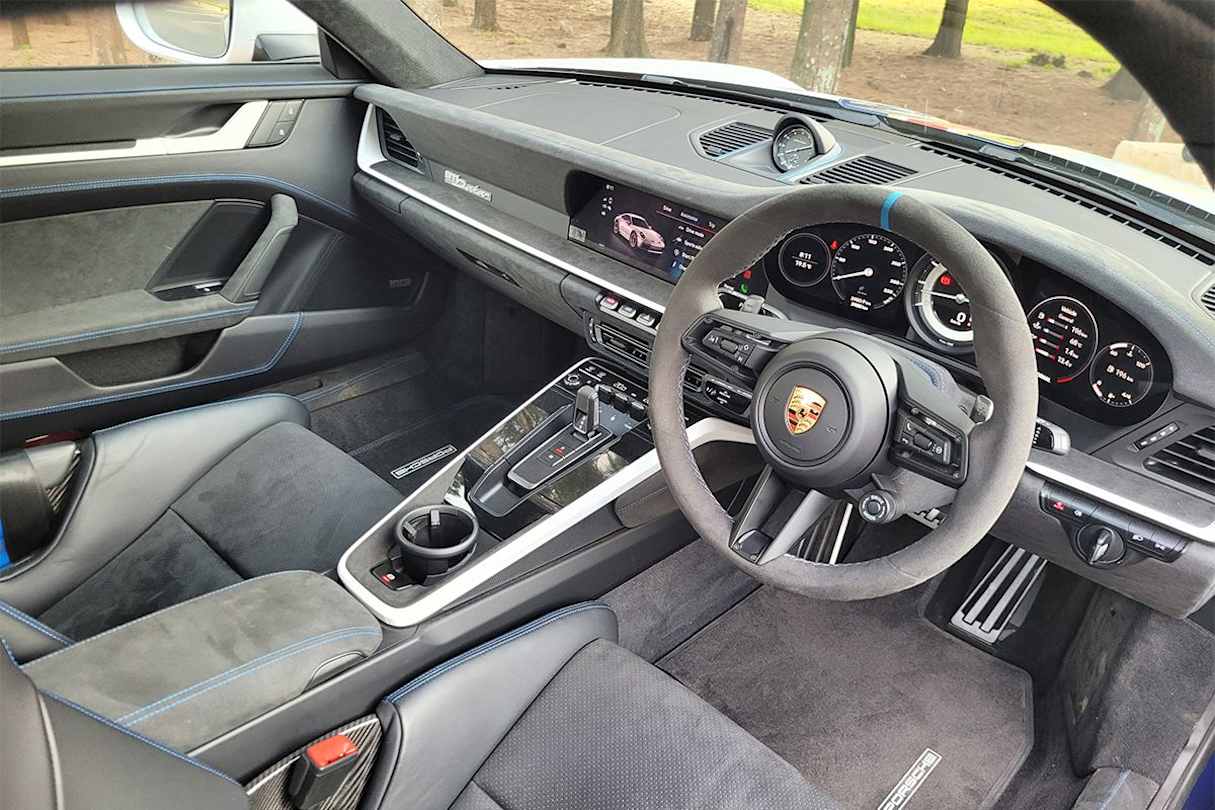
However, it’s worth noting if you add the Rallye Design Package and get the roll cage it will cut down on the amount of usable storage space. Without it, you can use the now-carpeted space where the rear seats would go for extra storage, but with the cage you can only squeeze a few soft items in. The rest has to go under the bonnet in the relatively deep but narrow front storage space, which measures 132 litres.
So, if you do want to take an extended road trip in your 911 Dakar, springing for the roof storage system would be a helpful idea.
Under the bonnet – What are the key stats for its engine and transmission?
8 / 10
While it has elements of the 911 GT3, the 911 Dakar is based on the Carrera 4 GTS Coupe, at least from a powertrain point of view. Both models share the same 3.0-litre twin-turbo flat-six engine tuned to make 353kW/570Nm, paired with Porsche’s eight-speed dual-clutch transmission as standard. Naturally, it’s also fitted with Porsche’s all-wheel drive system, but the Dakar gets some unique features.
For starters, it’s equipped with the same trick engine mounts as the 911 GT3, which are stiffer to cope with extra off-road driving.

The all-wheel drive system features two unique modes - 'Rallye' and 'Off-Road', designed for improved loose surface performance. The former sets the all-wheel drive with a rear-bias and primes the powertrain for sporty driving, while the latter actives the differential lock for better slippery surface traction, also setting the engine and transmission for maximum low-speed response.
One major difference between the Dakar and the Carrera 4 GTS (owing to the former's off-road changes) is a much lower top speed; 240km/h compared to 309km/h for the GTS. The 0-100km/h times are almost identical, though, with the Dakar taking just 3.4 seconds and the GTS 3.3 seconds.
Efficiency – What is its fuel consumption? What is its driving range?
8 / 10
Despite the knobby tyres and extra weight (which is only 10kg in standard form, but will obviously blow out if you get the roof basket and load it up) fuel economy for the 911 Dakar is only fractionally heavier than the GTS. Its official rating is 10.5L/100km and on test, which included spirited driving on- and off-road, plus a mixture of motorway and urban running, we returned 12.6L/100km, which is solid for a sports car.
Coupled with the 67-litre tank, you’ll have a theoretical range of 638km on a full tank, which won’t get you across the outback but is respectable for this type of car. It isn’t a Toyota LandCruiser so obviously it won’t get you quite as far on a single fill.
Driving – What's it like to drive?
9 / 10
Porsche isn’t known for doing things in half-measures, so it should come as no surprise that the 911 Dakar has some serious off-road potential. Thanks to the extra ride height, underbody protection and the new tyres the Dakar has some strong off-road credentials.
It has 161mm of ground clearance, which is only 26mm less than a Macan. Porsche also claims an approach angle of 14.2 degrees, a breakover angle of 16.2 degrees and a departure angle of 16.4 degrees.
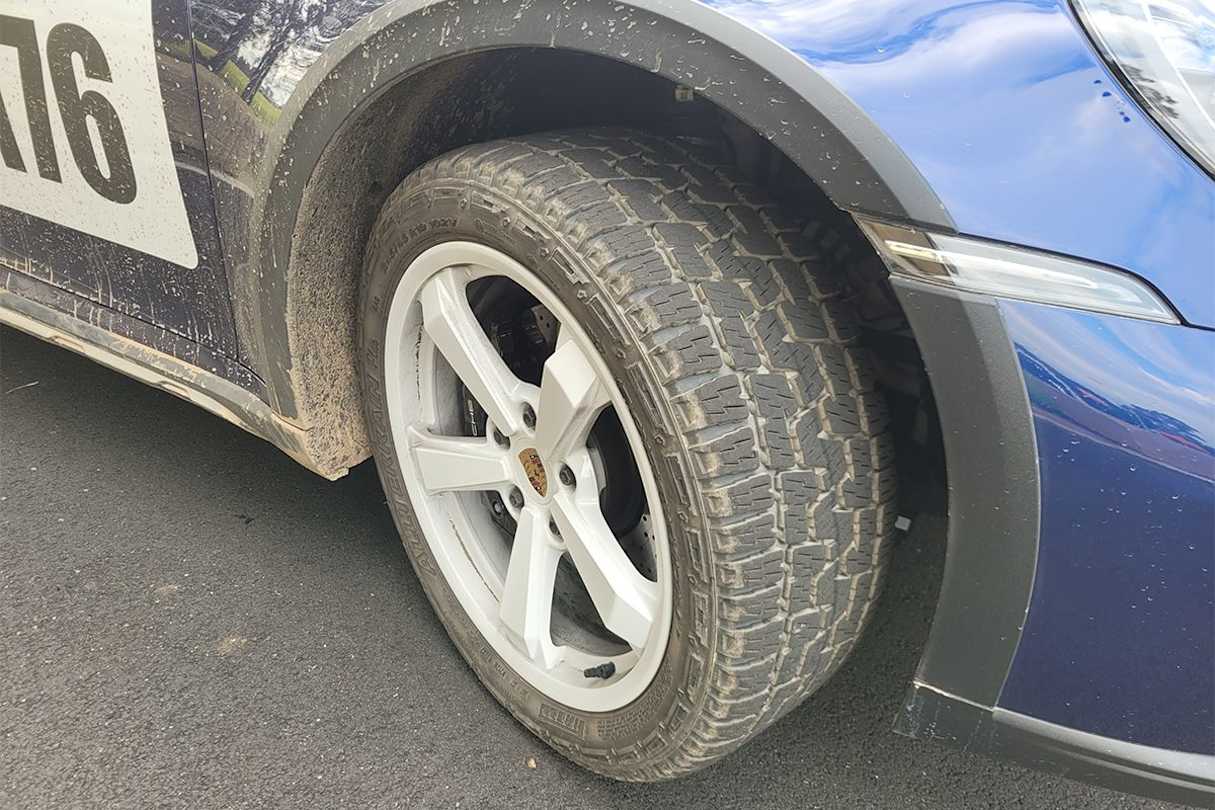
Even so, the idea of taking a Porsche 911 off-roading still feels unusual, especially when you get gravel under the tyres… and yet, the Dakar feels at home. With the drive mode set to Off-Road and maximum ride height engaged, the Dakar is more than capable of navigating some very rough terrain.
We headed down some rugged trails in the Blue Mountains, west of Sydney, and after some heavy rain the previous weeks, the surface was extremely rutted, chopped up and littered with large gravel. While you wouldn’t put it in the same off-road capability class as a 70 Series LandCruiser, the Dakar had no trouble navigating roads that would normally break a sports car. Even when we came across a water crossing the Porsche just powered through it without any issue.
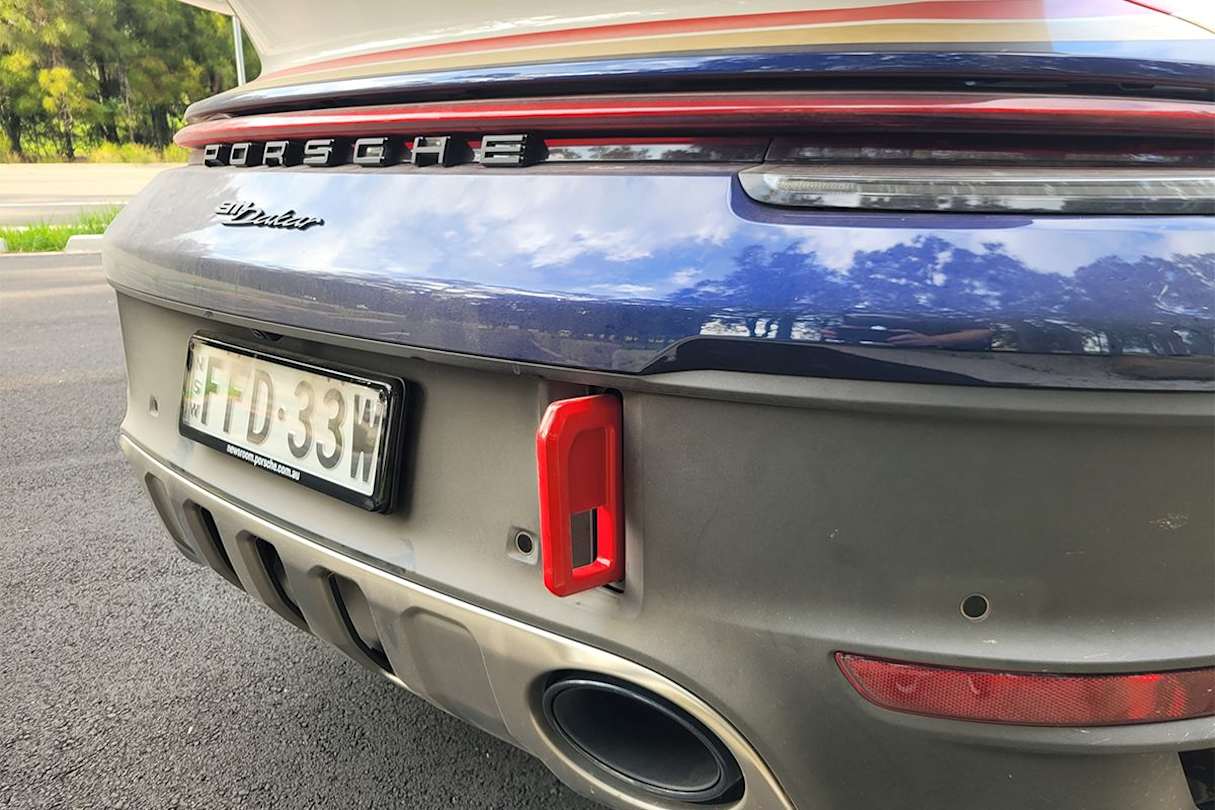
Back on sealed roads, and despite the knobby Pirellis, the 911 Dakar handles just as well as you’d expect a Porsche sports car to. It doesn’t feel significantly slower or dulled by its off-road elements and instead has the same smooth, effortless performance that has made this model a sports car icon. It's obviously not quite as precise and poised as a 911 GTS on road tyres would be, but it's not far off.
The everyday added bonus of the Dakar’s off-road upgrades is, unlike any other sports car (except maybe Lamborghini's Huracan Sterrato), you never need to worry about speed bumps or potholes, so it would actually make for a surprisingly liveable daily driver.
Warranty & Safety Rating
Safety – What safety equipment is fitted? What is its safety rating?
7 / 10
Porsche equips the 911 Dakar with airbags for both occupants, covering the front, thorax and sides plus cruise control is standard. However, there’s no suite of active safety features, with only ‘Warn and Brake Assist’ standard and the Dakar missing out on the 'Lane Change Assist' that’s fitted to the 911 GTS.
Given ANCAP requires seven cars for each crash test it’s unlikely the organisation will spend the $1.9 million it would need to get its hands on enough 911s; and certainly not the limited edition Dakar.
But that’s in no way meant to insinuate the 911 is an unsafe car. Far from it. It feels solid and secure, and its responsive and direct handling certainly impacts its active safety, while it has the key passive safety features, with full airbag coverage.
Ownership – What warranty is offered? What are its service intervals? What are its running costs?
7 / 10
While most car brands, even the premium ones, have moved to at least a five-year warranty, Porsche is sticking with three years (and unlimited kilometres). But you can extend the warranty, for a price, through your local dealer.
Porsche has also bucked the common trend for capped price servicing, with costs varying from model to model and across states and each dealership, so you’ll need to consult with your local showroom to get a clearer picture. Service intervals are every 12-months or 15,000km, whichever comes first.
Verdict
Personally (and I’m expecting some hate from the fans in the comments), I hope Marvel slows down on the superhero movies and shows, but Porsche can keep doing its thing if cars like the 911 Dakar are the result.
It’s certainly a very niche offering, and one that will almost certainly go to collectors in this instance. But even that didn’t stop Porsche from investing in proper off-road upgrades to ensure the 911 Dakar is just as capable in its element as the 911 GT3 is in its and every other member of the range.
There’s been no official word from Porsche, but my hope is the 911 Dakar follows the same scenario we saw the the previous-generation 911 R. That was another strictly limited special edition, basically a GT3 without the big wing, and it was so popular it spawned the 911 GT3 with Touring Package for this latest generation.
It may be unusual and unlikely, but the 911 Dakar is also unquestionably a great addition to the already extensive 911 range.
Pricing Guides
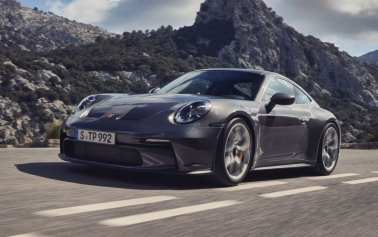








.jpg)
.jpg)






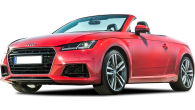



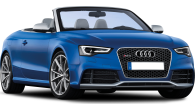








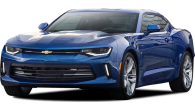













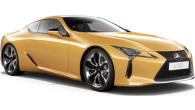
















.jpg)
.jpg)




